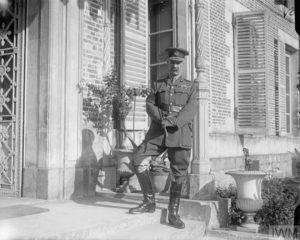Sunday July 14th, 1918
Reveille 6:30am. Raining hard, work one hour digging trenches for aircraft defence.
A General Calls
Today, on very short notice, General Henry Rawlinson, commander of the Fourth Army inspects the Battalion. He stays ten minutes – the Battalion commander sounds non-plussed.
General Rawlinson, The Fourth Army & The Somme, 1916

General Henry Seymour Rawlinson (1864-1925), the son of a reknowned Middle East scholar, was a career army man. After Eton and Sandhurst, he joined the King’s Royal Rifle Corps in India in 1884. Rising steadily through the ranks he went on to serve in Burma and during the Second Boer War.
In early 1916 Rawlinson was appointed commander of the newly created Fourth Army and the upcoming Somme offensive.
Flawed tactics and inflexible execution led to almost 60,000 of Allied casualties on the first day of the offensive. The Battle of the Somme lasted five months, casualties from both sides totalled ~1 million, and the Allies gained a strip of territory 10 km deep by 32 km wide.
In the aftermath of the war, the Battle of the Somme became the poster child for the futility and waste of WWI. However recent reassessment by commentators has started to judge its ‘achievements’, especially in the context of the Battle of Verdun, more favourably.¹
Hugh Sebag-Montefiore wrote that part of the blame for the Somme fell on the poor working relationship between Rawlinson and Haig.² While more junior heads rolled, the historian Martin Middlebrook wrote that ‘Haig and Rawlinson were protected by the sheer enormity of the disaster’. The full extent of casualties was not made public until after the war.³
Despite everything, Rawlinson was promoted to permanent General only months later and assigned the command of the Second Army. In February 1918, he became the British Permanent Military Representative to the Inter-Allied Supreme War Council at Versailles.
General Rawlinson & the Fourth Army, 1918
Rawlinson has just returned to command the Fourth Army in July 1918 – in time for the Allied counter-offensive. The Fourth Army’s recent series of successful limited battles, the most recent at Le Hamel only ten days ago, reveal improved tactics for modern warfare. With new confidence, Haig will assign Rawlinson the planning of the attack on Amiens early next month. Going forward, the Fourth Army will play a key role in the coming Hundred Day Offensive and Rawlinson’s reputation re-set.
After the war, Rawlinson will be feted, knighted and raised to the peerage. In 1920, he will become Commander-in-Chief, India. Still in post, he will die in Delhi after a brief illness in 1925.
13th (Service) Battalion War Diary – 14th July 1918 – Abancourt, France
Sunday RC Church parade in Church, Lannoy Village. All Companies worked on Bombardment slits in reliefs. Information received 15:00 hrs that the Battalion would be inspected by the Army Commander at 16:00 hrs The 4th Army Commander, General Rawlinson, arrived 16:30 hrs. Inspection lasted about 10 minutes. Lt Trevivian and 3 OR on leave.
References & Further Reading
¹ Five things you need to know about the Battle of the Somme in IWM
² ‘The British General whose infighting lost the Battle of the Somme‘ by Hugh Sebag-Montefiore on History Extra
³ General Rawlinson on Wikipedia
* Q 4032, copyright Imperial War Museums


